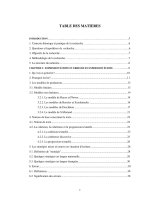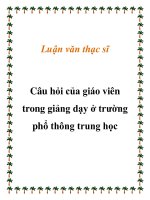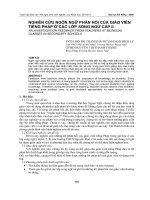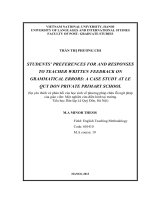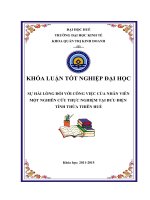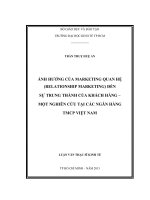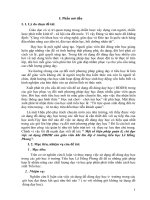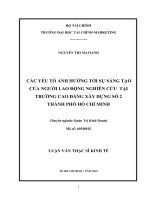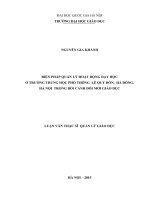Sự yêu thích và phản hồi của học sinh về phương pháp chữa lỗi ngữ pháp của giáo viên Một nghiên cứu tại trường Tiểu học Dân lập Lê Quý Đôn, Hà Nội
Bạn đang xem bản rút gọn của tài liệu. Xem và tải ngay bản đầy đủ của tài liệu tại đây (1.06 MB, 71 trang )
VIETNAM NATIONAL UNIVERSITY, HANOI
UNIVERSITY OF LANGUAGES AND INTERNATIONAL STUDIES
FACULTY OF POST- GRADUATE STUDIES
TRẦN THỊ PHƢƠNG CHI
STUDENTS’ PREFERENCES FOR AND RESPONSES
TO TEACHER WRITTEN FEEDBACK ON
GRAMMATICAL ERRORS: A CASE STUDY AT LE
QUY DON PRIVATE PRIMARY SCHOOL
(Sự yêu thích và phản hồi của học sinh về phương pháp chữa lỗi ngữ pháp
của giáo viên: Một nghiên cứu điển hình tại trường
Tiểu học Dân lập Lê Quý Đôn, Hà Nội)
M.A MINOR THESIS
Field: English Teaching Methodology
Code: 601410
M.A course: 19
HANOI, 2013
VIETNAM NATIONAL UNIVERSITY, HANOI
UNIVERSITY OF LANGUAGES AND INTERNATIONAL STUDIES
FACULTY OF POST- GRADUATE STUDIES
TRẦN THỊ PHƢƠNG CHI
STUDENTS’ PREFERENCES FOR AND RESPONSES
TO TEACHER WRITTEN FEEDBACK ON
GRAMMATICAL ERRORS: A CASE STUDY AT LE
QUY DON PRIVATE PRIMARY SCHOOL
(Sự yêu thích và phản hồi của học sinh về phương pháp chữa lỗi ngữ pháp
của giáo viên: Một nghiên cứu điển hình tại trường
Tiểu học Dân lập Lê Quý Đôn, Hà Nội)
M.A MINOR THESIS
Field: English Teaching Methodology
Code: 601410
M.A course: 19
Supervisor: Pham Minh Tam, M.Ed
HANOI, 2013
i
DECLARATION
I hereby certify that the thesis entitled “
Students’ Preferences for and
Responses to Teacher Written Feedback on Grammatical Errors: A Case
Study at Le Quy Don Private Primary School”
is the result of my own research
for the Degree of Master of Arts at University of Languages and International
Studies, Vietnam National University - Hanoi and that this thesis has not been
submitted for any degree at any other university or tertiary institution.
Hanoi, May 2013
Signature
Trần Thị Phƣơng Chi
ii
ABSTRACT
This study aims to explore the fit between teachers’ written feedback on
grammatical errors and the students’ preferences and strategies for handling the
feedback on their written works in a primary school in Hanoi. The study used a
triangulation of participants and methods in which the practice of feedback was
seen from the perspectives of students and teachers. Data were collected from
students’ worksheets, questionnaires and interviews. Firstly, worksheets of 25
fourth-graders marked by two teachers were collected in order to work out the
teacher’s feedback types on grammatical errors. Participants were then asked to
fill in the questionnaires concerning their feedback preferences. Finally, semi-
structured interviews were employed to seek for students’ responses to the
feedback they received. The results indicated that students’ preferences for
teacher feedback vary from class to class and the students’ strategies for
handling feedback varied depending on the type of feedback each teacher gave
on the students’ paper.
Key words: teacher written feedback, grammatical errors, preferences, responses,
English as a foreign language
iii
ACKNOWLEDGEMENTS
In completing this thesis, I owe my particular debt of gratitude to a great
number of people.
First and foremost, I am deeply grateful to my supervisor, Ms. Pham Minh
Tam who has always been ready and willing to help me make the study possible.
She has put enormous effort into editing and providing valuable comments. I
would not have completed this study without her help and encouragement.
My thanks also go to all teachers at the Faculty of Post-Graduate studies,
University of Languages and International studies, VNU- Hanoi. It is their
precious lectures and instructions as well as valuable suggestions that help me
understand issues related to my study and teaching.
I would also like to thank the authors of the books and studies that I have
consulted in order to understand and investigate my research problem.
Last but not least, I must record my deep gratitude to all members in my
family. It is their enduring love, care, support and encouragement that help me
finish this study.
iv
TABLE OF CONTENTS
Declaration
i
Abstract
ii
Acknowledgements
iii
Table of Contents
iv
Chapter 1: INTRODUCTION
1.1 Statement of the Problem and Rationale for the Study
1.2 Objectives of the Study
1.3 Research Questions
1.4 Scope of the Study
1.5 Methodology of the Study
1.6 Significance of the Study
1.7 Organization of the Study
1
3
3
3
4
4
5
Chapter 2: LITERATURE REVIEW
2.1 Language Errors.
2.1.1 Definitions of Language Errors
2.1.2 Classification of Language Errors
2.1.3 Grammatical Errors
2.1.4 Approaches to Error Correction
2.2 The Role of Written Feedback
2.2.1 Error Correction as Focus-on-Form Intervention
2.2.2 Error Correction to Facilitate Noticing
2.3 Teacher Written Feedback on Grammatical Errors
2.3.1 Definitions of Teacher Written Feedback
2.3.2 Classification of Written Feedback
6
7
9
11
13
14
14
14
v
2.3.3 Error Correction Codes
2.4 Students’ Preferences and Responses for Teacher Feedback
2.5 Related Studies
16
17
18
Chapter 3: RESEARCH METHODOLOGY
3.1 Research Context
3.1.1 Curriculum Policy
3.1.2 The Case
3.2 Research Questions
3.3 Research Approach
3.4 Participants
3.5 Data Collection Instruments
3.5.1 Documentation
3.5.2 Questionnaire
3.5.3 Semi - structured Interviews
3.6 Data Collections Procedure
3.7 Data Analysis Procedure
3.8 Validity and Reliability of Data
21
22
23
23
24
25
26
27
28
29
30
Chapter 4: RESULTS AND DISCUSSION
4.1 Results
4.1.1 Research Question 1
4.1.2 Research Question 2
4.1.3 Research Question 3
4.2 Discussion
31
32
35
38
Chapter 5: CONCLUSION
5.1 Summary of the Study
5.2 Pedagogical Implications
5.3 Limitations of the Study.
5.4 Recommendations for Further Research
40
40
43
44
vi
REFERENCES
APPENDIXES
Appendix A: Types of Written Feedback
Appendix B: Types of Grammatical Errors
Appendix C: Sample worksheet marked by Teacher A
Appendix D: Sample worksheet marked by Teacher B
Appendix E: Interview Question (English version)
Appendix F: Interview Question (Vietnamese version)
Appendix G: Questions for Interview (English version)
Appendix H: Questions for Interview (Vietnamese version)
TABLES
45
50
51
52
53
54
55
56
56
1
Chapter 1: INTRODUCTION
This chapter begins with the presentation of the statement of the problem
and rationale for the study. Next, it presents the aims and scopes of the study as
well as the research questions to which the study seeks to find answers. This is
followed by a brief description of methodology used in the present study. Finally,
the chapter concludes with a description of the organization of the thesis.
1.1 Statement of the Problem and Rationale for the Study
Teacher feedback has long been regarded as an essential part in language
teaching and learning because it not only helps students to correct their own
mistakes but also enhances more confidence about their language competences.
Feedback may focus on either forms or contents or both.
It was clearly seen that young learners of English as a foreign language
often commit grammatical errors in their writing. Therefore, teachers’ giving
feedback on their errors is considered to be necessary for students’ proficiency.
However, the effectiveness of feedback does not lie in itself but by many other
factors such as students’ preferences for and responses to the teacher feedback.
That is the reason why teachers need to take into account some questions: ―What
feedback strategies does a teacher actually use when providing feedback on
grammatical errors‖, ―Do students like their teachers’ feedback type?‖, ―How do
they react when receiving feedback?‖
Up to now, studies of language education have given considerable
attention to the issue of how to provide feedback on students’ writing (Diab,
2005, Wang, 2010; Katayama; 2007). Yet, the effectiveness of written feedback
on grammatical errors has been under-explored (Russel, J.M 2003). Some
attention has been given to investigate whether certain types of written feedback
2
may be more effective than the others, but the findings are not inclusive.
Additionally, which feedback strategies would fit the needs of particular students
is still questioned. Addressing these issues will require time and commitment of
a number of researchers. The research being reported in this study contributes to
the agenda by investigating the fit between teachers’ practices, students’
preferences and strategies for handling feedback on their written work.
Much as important written feedback on grammatical errors is, there have
been few studies comprehensively dealing with the issue. There is also a lack of
consensus over such matters as what feedback strategies is the most effective to
correct grammatical errors in particular context, what feedback types are
preferred by students and how students respond when they receive teacher
feedback. Moreover, almost all of the feedback studies on students’ preferences
and responses have been conducted in college/ university setting.
Owing to the lack of consensus on the effectiveness of teacher feedback,
this study aims to gain more insights into giving effective feedback by asking
what students think, want and do after they receive teacher feedback.
There is a paucity of research that addresses the elementary context. In
Vietnam, a focus on primary school students is important since they are those
who have chances to access English as a foreign language from the very young
ages (7-11). This study is an attempt to examine the real situation of written
feedback on grammatical errors conducted at the Le Quy Don Private Primary
School and to propose some suggestions for the betterment of the current
practice.
As most of the past studies have pursued the inquiry of teacher feedback
in two general ways, namely students’ preferences for teacher feedback
(Hedgcock & Lefkowitz, 1994; Hiroko, 1994; Leiki, 1999) and students’
responses to teacher feedback (Cohen,1987; Ferris, 1995, Chiang, 2004), this
study follow the similar traits and attempts to find out how students perceive
3
teacher feedback, what they are concerned about, and what they do after
receiving teacher feedback.
1.2 Objectives of the Study
This research is conducted for the following purposes:
1. To explore the teachers’ written feedback types in respond to students’
grammatical errors.
2. To investigate the students’ preferences towards different types of
feedback
3. To find out the students’ strategies for handling feedback after they have
received their written work
1.3 Research Questions
This study is conducted to answer the following research questions:
1. What are the types of teacher written feedback on the students’
grammatical errors?
2. What are the students’ preferences for different types of teacher feedback
on grammatical errors?
3. How do students handle the feedback they receive?
1.4 Scope of the Study
This study limits itself to the exploration of the types of written feedback
on grammatical errors that were commonly used by the teachers in the study, the
students’ preferences for and responses to each feedback type. Alternative types
such as oral corrective feedback by teachers and peer-to-peer feedback from the
students are beyond the scope of this study. The impact of teacher feedback on
learners’ proficiency is also not the objective of the study.
4
The present research was conducted at a private primary school in Hanoi,
with two teachers and two classes of young learners enrolled in Let’s Go 4
course. Teachers and students in classes that are not in primary school system are
outside the scope of this study.
1.5 Methodology of the Study
This is a case study with the presence of two teachers and two groups of
students. The teachers were teaching English to fourth-graders at Le Quy Don
Private Primary School in Hanoi. Data were then analyzed by means of
descriptive statistics to identify the patterns of feedback employed by the
teachers. The students’ preferences were elicited through the questionnaires and
students’ responses to teacher feedback on grammatical errors were collected
from teacher’s interviews.
1.6 Significance of the Study
Providing feedback involves in teachers’ regular practice. Feedback, as a
means of communication from the teachers, needs the responses from the
learners in order to enhance its efficacy. Consequently, the link between
teachers’ practice of giving feedback, students’ preferences and students’
responses in primary school context are taken into account in this study.
Feedback provides students with the information on their performance and
learning progress. Therefore, it is important to know the feedback types
preferred by the young learners in the primary language classroom. Additionally,
it offers teachers of English a number of pedagogical implications in terms of
written grammar correction to the learners in this context. Specifically, teachers
can be informed about the effects of different feedback patterns, based on which
they can choose the ones that suit their students’ preferences and work for the
types of feedback that students react positively.
5
1.7 Organization of the Study
The thesis is composed of 5 chapters.
Chapter 1 presents the research focus and provides the rationale for it as well as
its aims, scopes, method, research questions and the significance of
the study.
Chapter 2 reviews the relevant literature, setting the theoretical foundation for
the data collection and analysis
Chapter 3 presents the methodology employed to carry out the present study.
This includes a discussion of the participants, the data collection
instruments and the procedures for data collection and analysis.
Chapter 4 presents the findings of the study with reference to the teacher written
feedback strategies and students’ preferences and response to
feedback and also their relationship.
Chapter 5 gives a brief summary of the main findings, from which pedagogical
implications are derived. This chapter also acknowledges the
limitations of the present study and provides suggestions for further
studies.
6
Chapter 2: LITERATURE REVIEW
The purpose of this chapter is to review the literature on the relationship
between teacher's written feedback and students‟ preferences and responses to
feedback on grammatical errors. This chapter starts with an overview of
language errors, and approaches to error correction. Literature on teachers‟
corrective feedback and students‟ preferences and reactions is also reviewed.
2.1 Language Errors.
2.1.1 Definitions of Language Errors
The definition of language errors is rather complex as different authors
have different ways of defining it. Regarding learners’ errors, error analysis
enthusiasts made a distinction between mistakes and errors, which are
―technically two very different phenomena‖ (Brown, 2004, p. 216).
In one study, Corder (1967, p.114) distinguished ―errors‖ and ―mistakes‖.
He stated that ―An error takes place as a result of lack of knowledge (i.e., it
represents a gap in competence)‖ and ―A mistake is a performance phenomenon,
reflecting processing failures that arise as a result of competing plans, memory
limitations, and lack of automaticity.‖
Brown (2004) also maintained that a mistake can be self-corrected, but an
error cannot. Therefore, native speakers can identify and correct them
immediately because they are fully aware of their mother tongue structures and
rules. Non-native speakers or second language learners not only make mistakes,
but also they commit errors since their knowledge of L2 structures and rules is
not sufficient. Brown (2004, p. 216) also stated that ―a mistake refers to a
performance error in that it is a failure to utilize a known system correctly; while
an error is a noticeable deviation from the adult grammar of a native speaker,
reflecting the interlanguage competence of the learner.‖
7
There may exist other ways of defining language errors, nevertheless, in
the scope of this study, the author concur that ―errors‖ are made when learner’s
knowledge of second language structures and rules are not sufficient and
―errors‖ cannot be corrected. Whereas, ―mistakes‖ are the results of competing
plans, memory limitations, and lack of automaticity and they can be self-
corrected.
2.1.2 Classification of Language Errors
Errors can be classified in different ways depending on the nature of
classification and the purpose of the author. In this thesis, the researcher provides
some typical ways of error classification.
Corder (1967) makes a distinction between expressive and receptive
errors which are manifestations of expressive and receptive behaviour and
depend upon knowledge of the ―formation rules‖ of a language: ―Inadequate
knowledge of these rules will therefore show itself in both sorts of behaviour.
Yet, it is much easier to detect imperfect knowledge in the case of expressive
behaviour. Expression leaves traces transient, but recordable, in the case of
speech, permanent in the case of writing.‖
Types of errors - Corder (1967)
Types of errors
Description
Expressive errors
Are manifestations of expressive behaviour
Receptive errors
Are manifestations of receptive behaviour
In 1974, Burt and Kiparsky classify errors into two categories: local and
global errors in terms of communicative perspective.
Local errors do not hinder communication and understanding the meaning
of an utterance. Global errors, on the other hand, are more serious than local
errors because global errors interfere with communication and disrupt the
meaning of utterances. Local errors involve noun and verb inflections, and the
8
use of articles, prepositions, and auxiliaries. Global errors, for example, involve
wrong word order in a sentence.
Types of errors - Burt and Kiparsky, 1974
Types of errors
Description
Local
errors
Do not hinder communication and understanding the meaning of an utterance
Involve noun and verb inflections, and the use of articles, prepositions, and
auxiliaries.
Global
errors
Interfere with communication and disrupt the meaning of utterances
Involve wrong word order in a sentence
It is also possible to categorize learner errors on the basis of the linguistic
levels testifying to their manifestation. Lee (1990, p.50), for instance, elaborates
on the following classification of learner errors:
Types of errors
Explanation
Grammatical
errors
Stress the need for grammatical accuracy in both speech and writing, may
hinder communication but errors at the sentence level ―often reflect
performance ―mistakes‖ for which immediate teacher correction is not
necessarily appropriate‖
Discourse errors
Depend on the observance of the rules of speaking and writing and reflect
learners’ cultural and pragmatic knowledge of language use.
Phonologically
-induced errors
Be manifested in wrong pronunciation and/or intonation; in the case of English
studied as a foreign language such errors necessitate timely correction on the
part of the teacher because vowel length, voiced and voiceless last consonants,
word stress, etc. may have a meaning-differentiating function, as in live/leave,
leave/leaf, exit (n.)/exit (v.), and so on.
Lexical errors
Belong to the other linguistic levels, may also hamper communication and
intelligibility
As can be seen, each researcher provided his/ her own way of classifying
the language errors. In their classifications, grammatical errors are proved to be
one kind of language errors that are in need of correcting to improve the
9
learners’ proficiency. Moreover, this thesis aims to investigate the teacher
written feedback on grammatical errors so grammatical errors are discussed
further in the next part.
2.1.3 Grammatical Errors
Grammar can be defined as a set of shared assumption about how
language works – (Yulianti, 2007, p. 11). Knowing about how grammar works is
to understand more about how grammar is used and misused – (Yulianti, 2007,
p. 12). It means that there is a possibility of error occurrence in students learning.
In this research, the term of error in grammar will be called grammatical errors.
Many definitions of grammatical errors can be found in various studies
and there are also many ways of classifying errors in terms of grammatical
aspect.
According to Dulay, et al. in 1982, p.138-139 grammatical errors are
categorized into 6 groups.
Types of errors
Description and examples
Omitting
grammatical
morphemes
Items that do not contribute much to the meaning of sentences, as in
He hit car.
Double marking
a semantic feature (e.g. past tense) when only one marker is required, as
in She didn‟t went back.
Regularizing rules
womans for women
Using archiforms
One form in place of several – such as the use of her for both she and
her, as in I see her yesterday. Her dance with my brother.
Using two or more
forms in random
Alternation even though the language requires the use of each only
under certain conditions, as in the random use of he and she regardless
of the gender of the person of interest
Misordering items in
constructions
It requires a reversal of word-order rules that had been previously
acquired, as in What you are doing?, or misplacing items that may be
correctly placed in more than one place in the sentence, as in They are
all the time late.
10
Another ways of classifying grammatical errors is found in Chaney’s
analysis of learner errors in 1999 cited in Ferris and Roberts’s (2001)
Description of Error Categories
Verb errors:
All errors in verb tense or form, including relevant subject-verb agreement
errors.
Noun ending
errors
Plural or possessive ending incorrect, omitted, or unnecessary; includes
relevant subject-verb agreement errors.
Article errors
Article or other determiner incorrect, omitted, or unnecessary.
Wrong word
All specific lexical errors in word choice or word form, including preposition
and pronoun errors. Spelling errors only included if the (apparent) misspelling
resulted in an actual English word.
Sentence
structure
Errors in sentence/clause boundaries (run-on, fragments, comma splices), word
order, omitted words, or phrases, unnecessary words or phrases, other
unidiomatic sentence construction.
In order to classify grammatical errors among different types of errors in
writing, I adopted the description of grammatical errors of Channey (1990) cited
in Ferris and Roberts’s (2001) as one of the key factors to collect research data.
Therefore, a description of the grammatical errors that have been used in this
study comes below:
Grammatical
errors
Description
Examples
Verb errors
Errors in verb tense or form
I meet her last week.
We have not complete the project yet.
Noun ending
errors
Noun ending (plural or possessive)
missing or wrong
These book are mine.
My father car is new.
Article
errors
Article (a,an, the) or other determiner
(some, any, a lot of, much, many…)
missing or wrong
There are much books on the table.
I live in the Tabiz
11
Wrong word
All types of lexical errors in word
choice or form, including preposition
and pronoun errors
My mother learned me how to ride a
bike.
I was interested at history.
Sentence
structure
errors
Errors related to sentence/clause
boundaries
My father took the bus. Because the bank
was not near.
Wrong word order
What you are doing?
Omitting words or phrases from a
sentence
I know he is. He is at the park.
Insertion of unnecessary words or
phrases
The woman whom I saw her was my
teacher.
2.1.4 Approaches to Error Correction
There are a large number of differences in attitudes towards errors and
error correction between traditional and modern methods of language teaching.
The brief overview of teacher roles, learner roles, error handling in
Grammar – Translation Method and Communicative Language Teaching are
listed in the table below:
Grammar-Translation Method
Communicative Language Teaching
Learner
Roles
Try to learn grammatical rules.
Read and write.
Translate.
Memorise rules.
Learners as negotiator, interactor,
giving messages as well as taking
them.
Teacher
Roles
Authority in the classroom.
The medium of instruction is Native
Language.
Grammar taught deductively.
Facilitator of the communication
process, participant tasks and texts,
need analyst, counsellor, process
manager.
Error
Handling
Mistakes are corrected immediately.
Self-correction facilitates language
learning, so the teacher encourages the
students to correct their mistakes.
Mistakes are tolerated, the emphasis
being on the message and not on the
form.
12
In traditional language classes, errors were not allowed. Errors were seen
as evidence of ineffective learning or even laziness. Also, teachers paid little
attention to how to correct errors effectively. If they corrected an error, it would
be giving the student the correct model and getting him/ her to repeat it.
However, Van Lier (1988) noted that in the late sixties and early seventies,
teachers began to comprehend that errors might be more an indication of learner
efforts to form a new linguistic system rather than linguistic failure. Specifically,
in the light of communicative language teaching, errors are seen as positive steps
towards learning. The teacher’s attitude towards correction is positive and
correction techniques are used to encourage students, not to put them down or
make them feel stupid. For these teachers, a perfect lesson is full of students'
errors, in which teachers' correction is an integral part.
Error correction is now seen as a technique to get students correct their
own errors and improve their linguistic competence. It means that in language
classes, when error correction is carried out, the negotiation of meaning and
negotiation of form, at the same time are of equal value. Thus, error treatment in
second language acquisition classroom has been investigated in a larger scale
and in a larger sense. These studies have all borrowed the framing questions of
the issue of error correction in the classroom used by Hendrickson (1978). Those
questions mentioned what, when, how and who should do the error correction.
Should learners' errors be corrected?
When should learners' errors be corrected?
Which errors should be corrected?
How should errors be corrected?
Who should do the correcting?
In conclusion, error correction has been investigated from the early time
of Communicative Language Teaching. In the scope of this study, the researcher
13
only examined teacher written feedback on grammatical errors in one primary
school to confirm conclusions drawn from earlier research.
2.2 The Roles of Written Feedback
It can be argued that providing written feedback is indispensable because
it plays an important role in guiding, motivating and encouraging students to
improve their accuracy in L2 writing (Brannon & Knoblauch, 1982). Despite the
process of providing written feedback being frustrating, difficult and time
consuming, teachers still prefer to provide written feedback as it allows for
individualized teacher-to-student communication that is rarely possible in the
day-to-day operations of an L2 writing class (Ferris, Pezone, Tade & Tinti,
1997). It is stated that written feedback serves two roles: Focus-on-Form
Intervention and Facilitate Noticing
2.2.1 Written Feedback as Focus-on-Form Intervention
Feedback is one of the pedagogical tools identified as focus-on-form
instrument (Ellis, 2005). According to Long (1991, p. 46), the focus-on-form
approach ―overtly draws students’ attention to linguistic elements as they arise
incidentally in lesson whose overriding focus is on meaning and
communication.‖ In other words, the L2 students’ attention will be drawn
explicitly to linguistic features as necessitated by communicative demand.
In addition, Long (1991) argues that language instruction based on focus-
on-form can be achieved in two principal ways. First, language activities can be
developed by requiring students to communicate while also focus their attention
on specific language structures. Second, language teacher can decide to provide
corrective feedback on students’ errors during the course of communicative
activities.
Considering this perspective, it can be inferred that feedback is provided
to focus students’ attention on grammatical accurate forms within the context of
performing a communicative task.
14
2.2.2 Written Feedback to Facilitate Noticing
As aforementioned, the Noticing hypothesis states that in order for
students to learn any aspect of L2, they need to ―notice‖ the relevant material in
the linguistic data provided within the environment. Thus, implications regarding
written feedback in L2 instrucition emerge. First thanks to teacher feedback,
students are able to pay attention to the existence of new features of L2. In
addition, students become aware and are able to locate the gaps between their L2
usage and that of L1 speakers. Secondly, written feedback might help students to
discover the limitations of their L2 communication abilities with their given L2
resources. Therefore, it can be argued that written feedback could function as a
―noticing facilitator‖ that directs the attentions of the L2 students not only
towards errors, but also towards new features of the target language.
2.3 Teacher Written Feedback on Grammatical Errors
2.3.1 Definitions of Teacher Written Feedback
Kepner (1991, p. 141) defines feedback in general as any procedures used
to inform a learner whether an instructional response is right or wrong.
Lightbown and Spada (1999, p. 172) define corrective feedback as: ―an
indication to the learners that his or her use of the target language is incorrect‖.
The learners may get this indication in various ways.
For the purpose of this research, feedback will strictly refer to the written
feedback given by teachers as responses to their students’ grammatical errors in
writing. The terms ―feedback‖, ―teacher feedback‖, ―teacher feedback on
grammatical errors‖ and ―teacher written feedback‖ in this research will be used
interchangeably and they do not constitute any real difference.
2.3.2 Classification of Written Feedback
An area of concern in the research on teacher feedback in foreign
language learners is error correction and its effects on student writing accuracy.
In this context, the errors are grammatical errors committed by ESL/EFL
15
students on their written texts. Thus, ―teacher written feedback‖ refers to the
feedback teachers give on students’ written errors.
In addressing grammatical errors on students’ writing, teacher can use
different feedback strategies such as direct and indirect feedback (Lee, 2003).
Types of Written Feedback (WF)
Type of WF
Description
Example
Direct feedback
Locate and correct errors
Has went
gone
Indirect feedback
(Direct location
of errors)
Locate errors
Has went
Locate errors and identify error types
Has went
verb form
Indirect feedback
(Indirect location
of errors)
Indirectly locate errors
Putting a mark in the margin to
indicate an error on a specific line
Indirectly locate errors and identify
error type
Writing ―verb form‖ (or V‖) in
the margin to indicate a verb
form error on a specific line
(adapted from Lee, 2003a)
Direct feedback refers to overt correction of student errors, that is,
teachers locating and correcting errors for students. Indirect feedback refers to
teachers indicating errors without correcting them for students. Some teachers,
when giving indirect feedback, locate errors directly by underlining or circling
the errors, while others may locate errors indirectly, for instance, by putting a
mark in the margin to indicate an error on a certain line. Whether teachers locate
errors directly or indirectly, they can further decide if they want to identify the
error types — by using symbols, codes, or verbal comments. For direct location
of errors, teachers normally put the symbols, codes or comments right above or
next to the errors underlined or circled. For indirect location of errors, teachers
may put a code or symbol in the margin to identify the error type on a certain
line. Table above summarizes the major error feedback techniques, with
examples to illustrate each type of feedback.
16
2.3.3 Error Correction Codes
Is the use of error codes (e.g. ―T‖ for ―Tense‖, N for ―Noun‖) in giving
error feedback coded feedback? Is it more beneficial than uncoded feedback?
Coded feedback rests on the premise that students are better able to correct errors
when alerted to the error types. One advantage of coded feedback is that the
error codes provide a common ground for teachers and students to discuss errors
(Raimes, 1991). Error identification, however, can be ―cumbersome for the
teacher and confusing for the students‖ (Ferrris, 2002, p. 67). Also, the use of
error codes is based on the assumption that students have a good understanding
of grammar and that when they see the codes they are able to correct errors right
away. Lee (1997) has, however, cautioned that teachers may be overestimating
students’ ability in using marking codes, and that teachers may be ―using a wider
range of metalinguistic terms than students could understand‖ (p. 47). The
usefulness of marking symbols/ codes has been further questioned by Ferris and
Helt (2000) and Ferris and Roberts (2001), who found that students did not
correct more errors when they were provided with error codes. Research has yet
to find out how useful and meaningful it is for teachers to mark students writing
all over the place with codes, especially with codes that are unfamiliar to or not
yet mastered by students.
Error Codes Used by Teachers
adapted from Lee (2003)
17
2.4 Students’ Preferences on Teacher Feedback
Students’ attitudes and preferences have also been explored in recent
literature on written feedback. Previous studies have consistently shown that L2
writing students want, expect, and value teacher feedback for the improvement
of their writing accuracy (Ferrris, 1995; Hedgecock & Lefkowitz, 1994;
Komura, 1999; Leki, 1991). Research also indicates that students rely on
teachers for feedback in improving their L2 writing (Lee, 2004). Further research
could explore in greater depth how these error correction preferences affect the
ability of students to develop their writing.
Results from two separate studies by Ferris (1997, 2001) indicated that all
students who participated in the study preferred their teachers to provide
corrective feedback to improve their L2 writing accuracy; the most preferred
types was implicit written feedback through the use of codes that label errors in
their writing. This suggests that students pay a great deal of attention to teacher
feedback and they appreciate having their errors implicitly corrected as a means
of improving their writing accuracy. Ferris’ findings also indicate that students
perceive implicit written feedback to be more effective in improving their
writing accuracy than explicit written feedback.
The findings from a study by Perpignan (2003) to explore the preferences
of Israeli post-graduate students taking up a course in EFL Accademic Writing
indicate that students’ preferences regarding corrective feedback vary between
explicit and implicit written feedback. Findings from the study indicate that was
rarely any agreement in the preferences of the students; which may have
stemmed from their varying beliefs in written feedback. This suggests that even
though the importance of students’ preferences in written feedback cannot be
ignored, diversity of preferences is also a possibility.
Considering the literature, it is noticeable that teachers view the provision
of written feedback as a positive pedagogic strategy. However, the findings from
